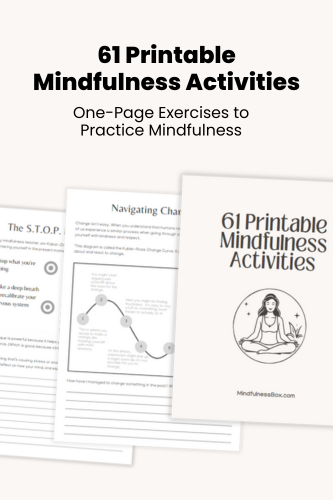Every year, a handful of countries around the world celebrate Thanksgiving—an annual excuse for family togetherness, and a reminder to be grateful for what we have.
When I was growing up, we got together with my extended family for Thanksgiving dinner. Before eating, everyone went around the table and read a gratitude-related quote. (For example, “In this food I see clearly the presence of the entire universe supporting my existence.” ― Thich Nhat Hanh).
But what happens after Thanksgiving?
Get dozens of one-page exercises to help practice mindfulness, meditation, gratitude, and self love. Perfect for printable handouts when teaching mindfulness to groups, students, or in the workplace.
To see examples, plus a full list of the 61 exercises included, click below.
Here’s what Google Trends has to say about the annual volume of people searching for the term “gratitude”:

Yikes.
Collectively, we are gratitude-crazy for the month of November.
Before and after? Not so much.
And that’s a shame, because gratitude is one of the few research-backed ways to feel happier and more positive.
What science says about gratitude
Researchers at the University of Miami found that writing just a few sentences per day about gratitude makes you feel more optimistic about your life.
Berkeley’s Greater Good Magazine has a handy rundown of key gratitude studies, which have repeatedly found that gratitude:
- Makes us happier and improves life satisfaction
- Reduces anxiety and depression
- Strengthens the immune system and lowers blood pressure
- Unshackles us from toxic emotions
- Helps us sleep better
- Improves relationships
With all these benefits, we have no problem taking 2-3 minutes a day to write what we’re grateful for, right?
Right?

Why is it so hard to stay grateful?
Gratitude, like any habit, is self-reinforcing.
If you’re someone who always goes to the gym, you don’t have to think about it. You just do it.
But if you’re just starting to go to the gym, you probably have to put in a considerable amount of work to create a habit that sticks.
You might coax yourself with rewards, or get an accountability partner to make sure you show up. And even so, if it’s rainy and you’re tired, you might still not go. (Yep, that happened to me this week.)
According to habits expert James Clear (who references this University College London study), it takes anywhere from two to eight months to form a habit.
Gratitude, in summary, is hard because forming any habit is hard. You’ve got to work at it intentionally before it comes automatically.
Without intention, other habits will build sturdy bridges in your mind. And they might not be so beneficial.
7 ways to nudge yourself back to gratitude
Why is it that we have to relearn so many of the same lessons in our journey as humans?
One that I keep learning, unlearning, and learning again:
“We see things not as they are, but as we are.” (writer Anaïs Nin).
That means—to use a metaphor from my elementary school days—that putting on your “gratitude glasses” can change most situations.
But most of the benefits of gratitude come with time and practice. Here are five ideas to keep the gratitude flowing in your life long after Thanksgiving.
1. Use a gratitude app
One of my favorite ways to nudge myself back to gratitude is with the app 3 Good Things (iOS / Android), which—in line with the gratitude studies I referenced earlier—encourages you to write three things you’re grateful for each day.
2. Print out physical reminders to be grateful
If you’re more of a “print things out” person instead of an app person, check out my 31 Days to Gratitude resource.
It includes a printable gratitude journal and planner, plus gratitude affirmations cards that you can put strategically around the house as reminders to be grateful.
3. Journal—but keep your focus on gratitude
If you already journal regularly, studies indicate that you’d be better off journaling more about the things you’re grateful for—and less ruminating about the negative experiences in your life.
4. Use gratitude affirmations
Here are a few gratitude affirmations to get you started:
- Gratitude is a filter that makes everything better. I choose to look at the world through eyes of gratitude.
- I’m committed to a life focused on joy and appreciation for what I have.
- As I breathe in, I’m breathing more gratitude into my life.
- I am grateful for the chance to grow into the best version of myself.
5. Try to “pivot” to gratitude in moments of difficulty
Back to the “gratitude glasses” I mentioned earlier. In moments of difficulty, ask yourself, “What would this moment look like if I approached it with gratitude?” You might be surprised how reframing the situation helps shift your perspective.
6. Step back and gain perspective
When I find myself spiraling into negativity, I no longer see clearly. It’s easy to get fixated on small things that don’t matter.
By stepping back and finding something—however small—to appreciate, you can put your current situation into perspective.
7. When all else fails, fake it until you make it
Have you ever heard about the study that found that smiling can make you happier—even if you’re faking it? It’s true, and it has implications for your pursuit of gratitude.
On those days when you just can’t find something to be grateful for, it’s okay to go through the motions. Do what you need to do to keep your habit of gratitude alive, because next time, you might just find a little more to be grateful for.
Staying grateful in the long run
It’d be nice if there were a more consistent way to become grateful. But the truth is, it’s often a rollercoaster journey with setbacks. You’ve got to get good at finding your way back to the habit.
Gratitude isn’t about hacks. It’s about cultivating a lasting shift in attitude.
As you’re finishing this article, why not take a moment to reflect on what you’re grateful for so far today?
Who knows—it could be the start of a new, transformational gratitude habit.

My mindfulness practice kicked off in 2016 with a ten-day silent retreat. Since then, I’ve read dozens of books about mindfulness and completed hundreds of hours of meditation. Thinking about what makes humans happy, calm, and peaceful is endlessly fascinating to me.


